An innovative study of
David Claerbout's work,
following the shady—and dark—logic, until now never raised by critics, that structures many of his films with mineral duration and slowness, but also number of “invisible” photographs.
The works of Belgian artist David Claerbout are marked by an interrogation of time as an artistic medium. Inspired both by phenomenology and by
Gilles Deleuze's writings on the image and cinema (“The Time-Image” and “The Movement-Image,” 1983), he has developed a kind of “photography in movement,” a “still movement,” into which he introduces narrative elements.
Navigating between the still and the moving image, between photographic and digital techniques, Claerbout produces works that are not easy to “consume”: looking at his work means spending enough time waiting for things to happen—an experience of duration which provides the viewer both the conditions and the desire to re-think what narration and story-telling can be in face of the image and its current technologies.
See also:
David Claerbout.
















